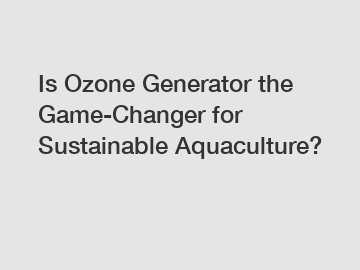Is Ozone Generator the Game-Changer for Sustainable Aquaculture?
Is Ozone Generator the Game-Changer for Sustainable Aquaculture?
In recent years, sustainable aquaculture has become a pressing issue as the demand for seafood continues to rise. Traditional aquaculture methods often face challenges such as disease outbreaks, water pollution, and high energy consumption. As the industry seeks innovative solutions to mitigate these issues, the use of ozone generators has emerged as a potential game-changer. This article will delve into the origins of ozone generators in aquaculture, the process of how they work, and the significance and impact they can have on the industry.
Ozone generators, also known as ozonizers, have been used in various industries for their potent oxidizing properties. Ozone, a naturally occurring gas, has been proven effective in disinfection, sterilization, and deodorization processes. Its ability to kill bacteria, viruses, and parasites makes it an ideal tool for maintaining water quality in aquaculture systems. Ozone generators produce ozone by passing oxygen through a dielectric barrier discharge, creating an electric field that splits oxygen molecules into individual atoms. These atoms then combine with other oxygen molecules to form ozone.

The use of ozone generators in aquaculture is primarily focused on water treatment. Ozone is a strong oxidant that can rapidly eliminate harmful pathogens, such as bacteria and viruses, without leaving any harmful residue. By treating incoming water before it enters the aquaculture system, ozone can greatly reduce the risk of disease outbreaks. Additionally, ozone can break down organic matter and pollutants, improving water clarity and reducing the need for chemical additives. Furthermore, ozone has a short half-life, meaning it decomposes back into oxygen quickly and does not leave any harmful byproducts in the treated water.
Several studies have shown the positive impact of ozone generators on sustainable aquaculture. For example, research conducted on shrimp farms demonstrated that using ozone for water treatment led to a significant reduction in total ammonia nitrogen levels and improved water quality. The improved water conditions resulted in healthier and faster-growing shrimp. Additionally, the elimination of pathogens reduced the need for antibiotics and other medication, further enhancing the sustainability of the operation.
The adoption of ozone generators in aquaculture brings various benefits to the industry. Firstly, the use of ozone reduces reliance on chemical additives, making aquaculture practices more environmentally friendly. This shift aligns with the growing consumer demand for sustainable seafood production. Secondly, by effectively controlling water quality and preventing disease outbreaks, farmers can reduce the risk of financial losses associated with mass mortality events. Lastly, the use of ozone can help improve the overall efficiency of aquaculture systems by reducing the energy requirements for water treatment and decreasing the need for frequent water exchanges.
In conclusion, the use of ozone generators in aquaculture has the potential to be a game-changer for sustainable practices. Their ability to effectively disinfect water, improve water quality, and reduce disease risks contributes to the overall sustainability and productivity of the industry. As more aquaculture operations adopt ozone generators, the environmental impact and economic viability of the industry can be significantly enhanced. It is evident that ozone generators are a promising solution for the future of sustainable aquaculture.
Contact us to discuss your requirements of ozone generator aquaculture water treatment , 50kg ozone generator, ozone generator manufacturer. Our experienced sales team can help you identify the options that best suit your needs.


